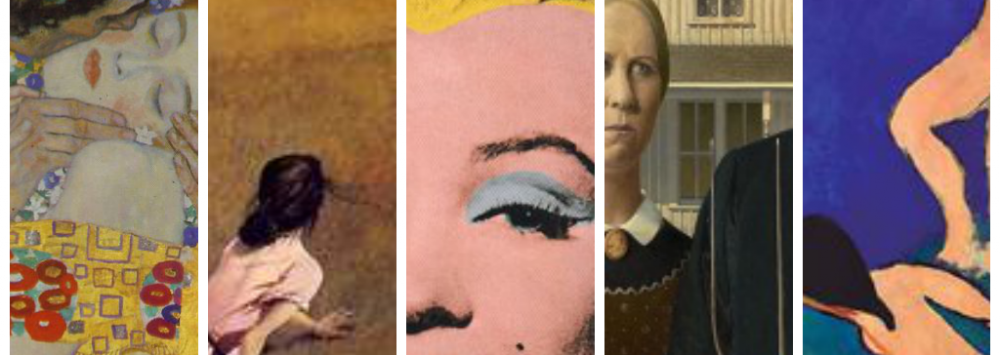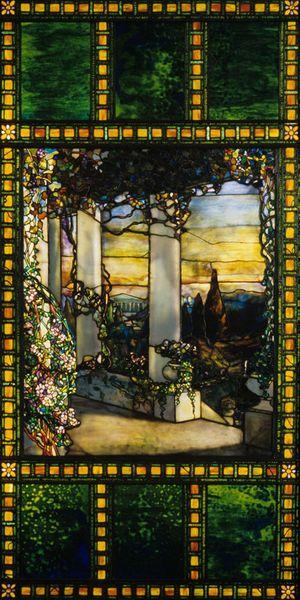LOUIS COMFORT TIFFANY
By: Natalie Pompos
Louis Comfort Tiffany is the son of the prominent Tiffany & Co. founder Charles Tiffany. Louis Tiffany achieved international recognition as a leader of the Art Nouveau Movement.
The Art Nouveau Movement
The Art Nouveau Movement emerged in 1893 when artist Victor Horta developed iron casting within the homes of the bourgeoisie in Brussels. The Art Nouveau Movement became an influential mode throughout design as well as architecture during the late 19th and early 20th centuries. The movement was in particular influenced by natural forms—particularly the depiction of flowers, leaves, and various plants. In addition, curved lines played an important role to harmonize the Nouveau style within natural environments.
**********
-
Tiffany was born on February 18, 1848 in New York City, New York.
Louis Tiffany achieved prominence as a world-renowned designer, painter, and most famously in the avenue of glass making. Tiffany interest in glass- making commenced in 1875. Three years later, he opened a glass-making company within New York City. In the mid-1880s he branched out from his parents and established his own business under the firm titled Tiffany Studios. Within the 1890s, his work flourished. His style for forming glass with lustrous colouring known as “Favrile,” elevated him to the position as the world’s frontrunner in glass production.
Before Tiffany pursued his interest in the arts he attended Eagleswood Military Academy in New Jersey. When he decided to pursue art formally, he began studying under the tutelage of a private instructor in New York City. In order to develop breadth within his studies, he enrolled in a selection of painting courses throughout Europe.
When Tiffany returned to America, he began studying at the National Academy of Design in New York. At this time in the mid-1870s, his work with stained glass began taking form.
Upon Tiffany opening his own business, he was immediately successful. He became internationally praised due to his work with opalescent glass, original colouring techniques, risk-taking, and intricate detailing. His pieces involving mosaics, blown glass, lamps, ceramics, and stained glass become widely popular. He honed a distinct approach to glass that resulted in iridescent and exquisite colouring. His special style was coined “Favrile.” This trademarked brand assisted in distinguishing his leadership in the field of glass construction. The year 1882, marked his greatest achievement. President Chester A. Arthur commissioned him to decorate interior portions of the White House.
In 1919, Tiffany retired from his illustrious glass-making career. He became a philanthropist and active member of New York City’s social scene. Unfortunately in 1932, his studios filed for bankruptcy. However at the time, he was no longer fulfilling the role of business owner.
On January 17, 1933 Tiffany passed his New York City residence at the age 84 years old.
***************
Tiffany’s commencement of his business marked a new era in glass manufacturing. He was revolutionary in the field of opalescent window glass. His work in this field was viewed as radical. The process involved the amalgamation and manipulation of various colours to construct an unprecedented number of mixed hues and three-dimensional effects. Tiffany was a fervent advocate of his technique because he valued its ability to allow the glass to develop via its innate course. Despite his popularity and that opalescent glass gained due to his promotion, artists who valued the traditional Gothic style of enamel paint applied to transparent uniform antique glass disregarded his technique.
***********
Natural elements are where Tiffany derived his greatest inspiration. He believed it was essential nature was the prime focus. Tiffany utilized his love of formulating colours to convert nature’s dense palate into his glasswork. His fascination with nature led to the development of his blown glass vases and bowls regarded as “Favrille.”
********
Selected Works
***************
21st Century Comparison
Joseph Cavalieri is a 21st Century New York City based artist. Despite specializing in a myriad of artistic mediums, Cavalieri specializes in stained glass. Similar to Tiffany, Cavalieri is revolutionary in the field of stained glass. His work incorporates traditional precise techniques via portrayals of popular culture icons. For example, he has done a significant amount of work involving television characters; such as the Simpsons. Cavalieri and Tiffany are both regarded for their value of vibrant colouring.
*************
Personal Reflection
My research regarding Louis Comfort Tiffany, has made me more aware and appreciative in a variety of ways. Foremost, I believed Tiffany Lamps were designed by the same individual responsible for Tiffany & Co. Jewelry. It was fascinating to learn Tiffany glass workings are the product of the Tiffany & Co. owner’s son. On another note, this week’s WARP has made me very appreciative of the lamps reposed throughout my grandfather’s residence. While growing up, he always made a point of showcasing his “Tiffany Lamps.” I can now understand how truly significant it is to own even a single one of Louis Comfort Tiffany’s lamps. I really enjoyed learning about the Art Nouveau Movement. Its focus on bright colouring and natural elements, compliments greatly with my own personal artistic values.
*************
Bibliography
“About Tiffany & Co.” Tiffany & Co. For The Press | . N.p., n.d. Web. 24 Apr. 2014. <http://press.tiffany.com/ViewBackgrounder.aspx?backgrounderId=9>.The Charles Hosmer Museum of American Art. Louis Comfort Tiffany, n.d. Web. 25 Apr. 2014. <http%253A%252F%252Fwww.morsemuseum.org%252Flouis-comfort-tiffany>.“Heilbrunn Timeline of Art History.” Louis Comfort Tiffany (1848–1933). N.p., n.d. Web. 25 Apr. 2014. <http://www.metmuseum.org/toah/hd/tiff/hd_tiff.htm>.“Louis Comfort Tiffany | The Tiffany Story | Tiffany & Co.” Louis Comfort Tiffany | The Tiffany Story | Tiffany & Co. N.p., n.d. Web. 25 Apr. 2014. <http://www.tiffany.com/WorldOfTiffany/TiffanyStory/Design/LouisComfortTiffany.aspx>.“Louis Comfort Tiffany.” Bio.com. A&E Networks Television, n.d. Web. 25 Apr. 2014. <http://www.biography.com/people/louis-tiffany-9507399>.“Tiffany Lamps.” , Antique Jewelry and Estate Jewelry. N.p., n.d. Web. 25 Apr. 2014. <http://www.macklowegallery.com/>.







